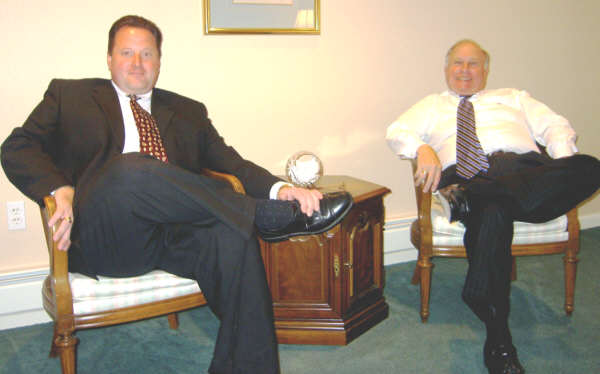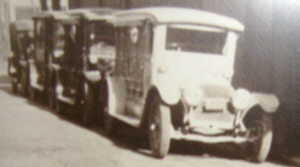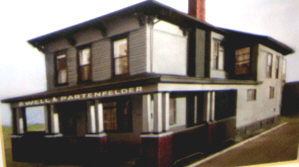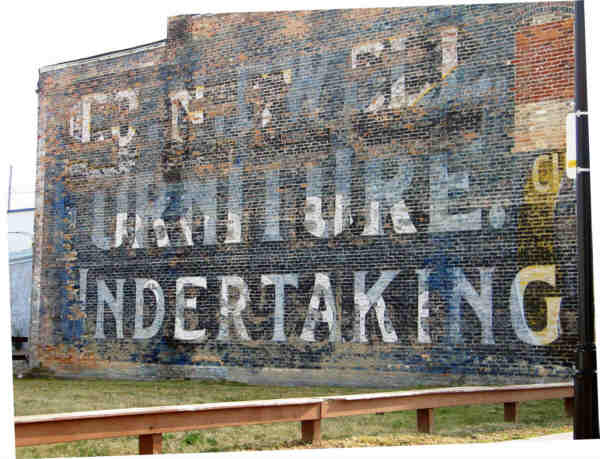www.mybaycity.com
July 29, 2007
(Prior Story) Business ArTicle 1749 (Next Story)
Sponsored by Bay Area Chamber of Commerce

Rick Steele, left, and Rich Steele, talk with a reporter about the long history of their funeral home. Penzien-Steele Funeral Home
|
||||||||||
| Printer Friendly Story View |
In 1898, when the forerunner of today's Penzien-Steele Funeral Home began business, the company was known as George N. Ewell Furniture and Undertaking.
A sign for the Ewell firm is still visible on the side of a building at Midland and Catherine streets. (Pictured at bottom of article).
Nineteenth century furniture dealers commonly sold coffins and acted as undertakers, in addition to supplying interior furnishing, according to a 1995 article in Smithsonian Preservation Quarterly by Peter Muldoon.
Below:(Left) White hearse, foreground, is last in a lineup of funerary vehicles lined up in an alley off Center Avenue in the early part of the century. (Right) Mr. Ewell operated his undertaking business from buildings at Fifth and Madison, Walnut Street and at 410 Center Avenue (pictured), located in Battery Park on an alley alongside the Bay City Elks Lodge.


In 1903 Walter Partenfelder became Ewell's partner and the firm was known as Ewell & Partenfelder. After Partenfelder's death in 1907, Arthur E. Vallender joined the firm that became Ewell & Vallender. In 1920 Ewell retired and Vallender moved the business to its present location at 608 N. Madison Ave.
Karl Penzien joined the company in 1943 and the name transitioned from Vallender & Penzien to Penzien & Vallender and finally just Penzien Funeral Home.
Richard C. "Rich" Steele, a graduate of Handy High School and Wayne State College of Mortuary Science, joined C. Baird Penzien and the firm was incorporated in 1974 with the name later changed to Penzien & Steele Funeral Home. Mr. Steele became sole owner following the deaths of Karl Penzien in 1986 and C. Baird Penzien in 1992. Richard C. "Rick" Steele II, a graduate of Michigan State University and the Wayne State mortuary school, joined his father in the business in 1993.
"While the root of funeral home business is old fashioned face-to-face personal service, technology and computers allow us to offer new services to people," says Rick Steele. These include memorial DVDs, in-house printed memorial folders and prayer cards and other recent innovations.
Cremation, that is growing slower here in a traditional Midwestern community, is adapting through addition of more than just the process itself, said Rich Steele. "More people want some kind of closure and a good number ask for traditional funeral services with the body present or memorial services with visitation," he said.
"It's important to be able to grieve, to gather with your support system of friends and family," said Rich Steele.
We are a long way from the days of more than a century ago when George Ewell started in business in Bay City by selling coffins as an adjunct to his furniture business.
"Coffin burial in America became common during the colonial period, heightening the demand for the manufacture of coffins and funerary services," wrote Muldoon, adding:
"Early American burials, of the seventeenth and eighteenth centuries, often took place in church yards. During the seventeenth century, most people were buried in simple cloth winding sheets. As Americans became more prosperous and urban areas more densely settled, coffin burial became increasingly common, and the services of a specialist became more necessary." Carpenters or cabinetmakers produced coffins as a sideline.
One modern trend, that of marketing coffins directly through the Internet, causes problems, according to the Steeles. "Third party sellers pick off the profits and the public may be left with an inferior product," says Rich Steele. "We urge people to look closely and make sure that what they buy is not a Chinese knock-off with no label. You may not be getting the value you deserve." According to Muldoon, a woodworking craftsman not only made coffins on demand but offered the additional funerary services of an undertaker. It was not unusual for a craftsman to advertise his services with the image of both a cradle and a coffin.
At first, an undertaker's duties simply consisted of attaching the lid of a coffin where it was customary to have an open coffin prior to the burial. Later these services were extended into the establishment of the funeral parlor or funeral home.
Even in cities and large towns, it took quite a while for undertaking to be distilled into a completely separate profession. Church yard burial required only the help of the pall bearers to remove the deceased to the grave. The advent of the landscaped, garden cemetery on the outskirts of town, necessitated a formal method of conveyance to the cemetery. The hearse, a glazed, horse-drawn funerary carriage, was designed for this practical and highly ritualized purpose. Penzien-Steele displays a photo of a lineup of early hearses in an alley off Center Avenue, including a vehicle painted white that was used for women and children.
The coffin's journey in the hearse was the instrumental focus of the funeral procession, which symbolized the soul's journey through life. As the nineteenth-century funerary rite expanded, becoming longer and more elaborate, the practice of embalming became more common. Therefore, funerary practices increasingly required more than just the services of a craftsman to nail, peg or screw down the lid of a coffin.
Penzien-Steele began a modest expansion when the firm purchased the former Hanlin Chapel in Vassar in 2003.

.
A sign for the Ewell firm is still visible on the side of a building
at Midland and Catherine streets.
###
at Midland and Catherine streets.
| Printer Friendly Story View |
|
|

Dave Rogers |
|
|
|
Printer-Friendly Story View
0200 Nd: 04-20-2024 d 4 cpr 0
12/31/2020 P3v3-0200-Ad.cfm
SPONSORED LINKS
12/31/2020 drop ads P3v3-0200-Ad.cfm


